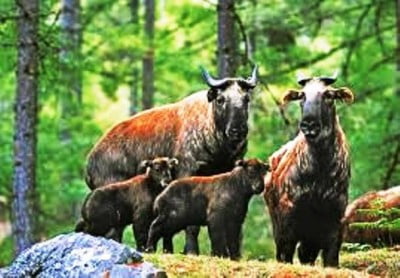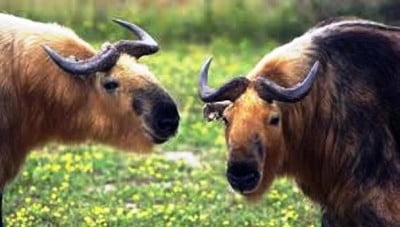
The national animal figures in Bhutan history as an object of fascination to various English visitors
Thimphu: Bhutan: In 1905, a British political officer photographed a baby Takin in Bhutan, in its natural habitat. In doing so, John Claude White (1853-1918) became the first European to obtain documentary evidence of the ungulate animal. Until then, the West considered the takin as a mythological animal and believed it was the 8th century Greek mythological animal, the gold-hair winged ram.
“It is of great interest, as being the first photograph of this curious ruminant ever taken; while the animal it represents is, I believe the first example of its kind ever seen alive by Europeans.” The journal of the Bombay Natural History Society, volume XVII records. “This animal was given by the Tongsa Penlop of Bhutan to Mr. J.C. White C.I.E., Political Officer, and Sikkim. It died the day after the photograph was taken.”
In 1914, the National Geographic magazine published the photo of the takin and the caption provides some background of the animal: “He [Takin] was brought to India, but unfortunately, the next day he was found dead; it is supposed poisoned by eating aconite.”
According to the proceedings of the zoological society of London, 1909, “The animal was captured by natives and brought to Mr. White’s camp, where it lived for some time, and appeared healthy that strong hopes were entertained of the possibility of transporting it to England. Unfortunately, it died suddenly, it is supposed to from having eaten the aconite which abounds in some part of the district.”
Two years later, in 1907-1908, JC White returned to Bhutan as the representative of the government of India to attend the coronation of our first king. This time, White entered Bhutan crossing the Tremola pass in Paro and exited via Jaigaon. On this trip, he managed to send specimens and a living takin to London.
“While at Poonakha [Punakha] I procured a specimen of the Takin a very rare animal, and I succeeded in bringing five specimens to England, which is now in the Zoological Gardens, London.”
The gardens named the takin, Budorcas taxicolor whitei in his honour.
During, the political officer’s second visit, he managed to get a baby takin from Gasa, in the northwest of Bhutan. The officer sent the animal to the zoological garden in London.
The zoological garden record confirms this. It states that the Bhutan takin arrived at the zoo on 22nd June 1909 and died on 7th May 1918.
Before sending the takin, White took photographs of the young animal and exhibited the photographs. The proceedings of the general meetings for the scientific business of the zoological society of London, 1909 states that the photograph of the takin was taken on board ship at Kolkata before the animal was presented to the society. “The Secretary added that he had ascertained that the Takin had reached Geneva about June 21st. It was the first Takin that had reached Europe alive.”
According to Flower (1929), this specimen was not only the first takin at London Zoo, but also the first such animal to reach Europe alive. The zoo considered it the most valuable animal.
The takin is the national animal of Bhutan. It has always been a subject of great interest to our visitors. The animal is believed to be made up of an ox, the antelope, a sheep and a goat. Because the takin is a rare and endemic to the eastern Himalayas, Europeans have always been curious. In addition to White, two other Englishmen were also fascinated with the animal and wrote about it.
Another English political officer, Charles Bell (1870-1945), a distinguished Tibetologist, who also authored a book on Bhutan, learnt about the animal from a Bhutanese. “On 15.10.1910 “Ugyen Kazi told me that “Takin’ are quite plentiful in the neighborhood of Ghassa [Gasa] and they live in the jungle on the hills above it.”
Bell was so intrigued by the animal and the mythology surrounding the creation of it that he researched and recorded the creation in his draft book on Bhutan: “A Bhutanese wandered around in Tibet and Bhutan. He was addicted to drinking, womanising, gambling, associating with low characters. At the same time very clever. The people asked him once to show some marvelous thing, saying, ‘We’ve heard you can make wonderful things. Do so, and we’ll believe that you’re undoubtedly a good lama, but do you have miraculous powers?’”
Then Drukpa Kinley took the bones and feet of a bullock and the head and skin of a goat, put the head on top of the bones, the skin around the bones, put life into the animal thus formed, and drove it into the forest. This animal was the takin, which has half goat, half bullock (but really half goat half deer?). There are two namthars of D.K.; one showing all his good deeds, and the other showing all his bad ones.”
The other Englishman, fascinated with the takin, was Malcolm Lyell (1921- 2011). Lyell was a close friend of our third and fourth kings. In the 1970’s, he trekked through the natural habitat of the takin in the northern part of Bhutan, an area that was largely restricted.
While White may have been the first to take a photograph of the takin, Lyell was certainly the first to take a colour photograph of the takin. Lyell took photos of baby takins that were being brought into the capital from the highlands.
“At the bottom of the valley we met three men with two baby takins. They said that they’d caught them the week before near Laya, on the King’s instructions, and were taking them to him in Thimphu. They said that the takins were 1½ months old. They had long straps attached to the animals, but were carrying them most of the time, and were feeding them on milk (although I noticed them grazing). Small horns were just beginning to show, and their natural instinct was to butt us.”
Lyell mentions in a note: “Nine days later, when we returned to Thimphu, we found the two Takins reached there safely and were happily wandering around the garden of the Royal Cottage, when we went to see the king.”
The note continues: “After leaving the King, we went to see the Takins in the grounds across the river from the Royal Cottage. Our wonderful Sangi Dorji of the Royal Body Guards who was with us on the 1974 trek is now in charge of the King’s zoo – but he was at lunch when we went to see the Takin. One of them was one of the two we had met as very small calves in Tsanre Geytang in 1974. The other had died.”
There are four species of takin and the Budorcas taxicolor whitei is indigenous to Bhutan, and the national animal of our country. Because it was first spotted by Mr. White, it has been named in his honour. Although the Bhutan takin in London Zoo died in 1918, the ones in Thimphu Zoo, brought down from the mountains in 1974, are thriving. The animal has become a major tourist attraction.
Courtesy Kuensel


